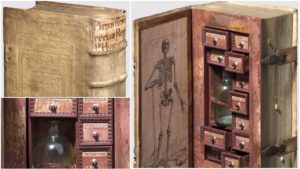One very early cipher involved replacing the vowels with dots. In his “Codes and Ciphers” (1939/1949) p.15, Alexander d’Agapeyeff asserts that this was a “Benedictine tradition”, in that the Benedictine order of monks (of which Trithemius was later an Abbot) had long used it as a cipher. The first direct mention we have of it was in a ninth century Benedictine “Treatise of Diplomacy“, where it worked like this:-
- i = .
- a = :
- e = :.
- o = ::
- u = ::.
“R:.:lly“, you might well say, “wh:t : l:::d ::f b::ll::cks” (and you’d be r.ght, ::f c::::.rs:.). But for all its uselessness, this was a very long-lived idea: David Kahn’s “The Codebreakers” (1967) [the 1164-page version, of course!] mentions the earlier St Boniface taking a dots-for-vowels system from England over to Germany in the eighth century (p.89), a “faint political cryptography” in Venice circa 1226, where the vowels in a few documents were replaced by “dots or crosses” (p.106), as well as vowels being enciphered in 1363 by the Archbishop of Naples, Pietro di Grazie (p.106).
However, perhaps the best story on the dots-for-vowels cipher comes from Lynn Thorndike, in his “History of Magic & Experimental Science” Volume III, pp.24-26. In 1320, a Milanese cleric called Bartholomew Canholati told the papal court at Avignon that Matteo Visconti’s underlings had asked him to suffumigate a silver human statuette engraved with “Jacobus Papa Johannes” (the name of the Pope), as well as the sigil for Saturn and “the name of the spirit Amaymom” (he refused). He was then asked for some zuccum de napello (aconite), the most common poison in the Middle Ages (he refused). He was then asked to decipher some “‘experiments for love and hate, and discovering thefts and the like’, which were written without vowels which had been replaced by points” (he again refused). The pope thought it unwise to rely on a single witness, and sent Bartholomew back to Milan; the Viscontis claimed it was all a misunderstanding (though they tortured the cleric for a while, just to be sure); all in all, nobody comes out of the whole farrago smelling of roses.
(Incidentally, the only citation I could find on this was from 1972, when William R. Jones wrote an article on “Political Uses of Sorcery in Medieval Europe” in The Historian: clearly, this has well and truly fallen out of historical fashion.)
All of which I perhaps should have included in Chapter 12 of “The Curse of the Voynich“, where I predicted that various “c / cc / ccc / cccc” patterns in Voynichese are used to cipher the plaintext vowels. After all, this would be little more than a steganographically-obscured version of the same dots-for-vowels cipher that had been in use for more than half a millennium.
As another aside, I once mentioned Amaymon as one of the four possible compass spirits on the Voynich manuscript f57v (on p.124 of my book) magic circle: on p.169 of Richard Kieckhefer’s “Magic in the Middle Ages”, he mentions Cecco d’Ascoli as having used N = Paymon, E = Oriens, S = Egim, and W = Amaymen (which is often written Amaymon). May not be relevant, but I thought I’d mention it, especially seeing as there’s the talk on magic circles at Treadwell’s next month (which I’m still looking forward to).
Finally, here’s a picture of Voynichese text with some annotations of how I think it is divided up into tokens. My predictions: vowels are red, verbose pairs (which encipher a single token) are green, numbers are blue, characters or marks which are unexpected or improvised (such as the arch over the ‘4o’ pair at bottom left, which I guess denotes a contraction between two adjacent pairs) are purple. Make of it all what you will!


